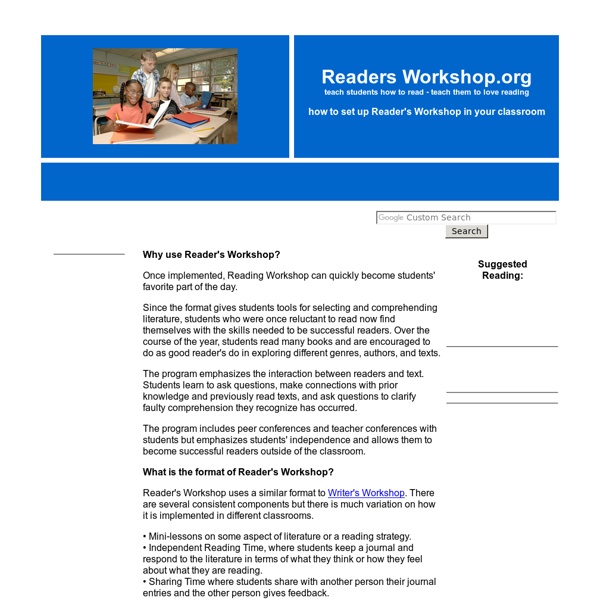



Readers' Workshop K-6 - Minilessons Planning for Daily Intentional TeachingWhat do my students need to know?What strategies and knowledge help them as readers?In what way does this strategy look different across genre?What language will I use?What texts/materials will best support this instruction?How can/will I connect this work to writing? Sources of Minilessons A huge list of planned mini-lessons...a must-see site! This is a fantastic template that reminds you of the structure and language to be used in a mini-lesson. Reader's Workshop This website is designed and maintained by Karen A. McDavid © 2004. Ideas, content, activities, and documents for this website are copyrighted by Karen A. All graphics seen throughout this website should not be removed, copied, or downloaded. You may download the banner below with a link back to this site. Graphics by
Interactive Read Aloud: How To Do It and Why It Works Every teacher should know how to do an interactive read aloud. Here is why it works and how to do it. When you consider a framework for best literacy methods within a classroom, daily read alouds from a variety of genres should be a foundational teaching practice. There are a variety of purposes for reading books out loud. Sometimes it is simply for pleasure, and that is an experience many students never received. Other purposes can include: develop background knowledge necessary for understanding a topictarget vocabulary developmentdemonstrate prosodylearn how to inference, make judgements and use meta-cognition strategiesintegrate higher order questioning skills set the stage for a unit or lessondevelop connections to a text (text-to-self, world or another text)meet academic content standards at a students frustration level However you choose to use reading aloud to kids, it should be done in a variety of ways across different genres, every single day. What is an Interactive Read Aloud? 1.
Independent Reading: 101 What is Independent Reading, Really? Independent reading is any time carved out of your day in which your students are reading self-selected books that are a "good fit" for them. There are different kinds of reading that may be going on in your room during this time and it will look different from classroom to classroom.The focus of this time is to support, encourage and validate your students as they grow as readers, through all of their ages and stages. When do I find the Time? Independent Reading is an indispensable part of the day in a literacy rich classroom. More Formal/ Larger Chunks of Independent Reading Time Informal (yet super powerful) Reading Times Getting Started: The Nuts & Bolts On Keeping Reading Logs For what purpose? Think of reading logs with a different purpose- to gather insight into reading habits in class, to use as a very informative means of getting to know your readers, styles, likes/ dislikes, comfort levels and preferences. On Use of Reading Levels
Reading Workshop - Information, ideas, and resources from Busy Teacher's Cafe The Reading Workshop is a teaching method in which the goal is to teach students strategies for reading and comprehension. The workshop model allows teachers to differentiate and meet the needs of all their students. Reading Workshop helps to foster a love of reading and gives students chances to practice reading strategies independently and with guidance. Many school districts use the Reading Workshop Model but there are other models of literacy instruction as well. This page gives a basic overview of the Reading Workshop. Components of the Reading Workshop: Description of each component: From Revisiting The Reading Workshop Choosing the Right Book: Strategies for Beginning Readers ReadWriteThink couldn't publish all of this great content without literacy experts to write and review for us. If you've got lessons plans, videos, activities, or other ideas you'd like to contribute, we'd love to hear from you. More Find the latest in professional publications, learn new techniques and strategies, and find out how you can connect with other literacy professionals. More Teacher Resources by Grade Your students can save their work with Student Interactives. More Home › Classroom Resources › Lesson Plans Lesson Plan Student Objectives Session 1 (30 to 40 minutes): Finding out what students do when choosing books Session 2 (20 minutes): Reading and thinking aloud to create vocabulary connections Session 3 (30 to 40 minutes): Modeling how readers choose a text Session 4 (40 minutes): Establishing a purpose for reading Session 5 (30 to 40 minutes): Applying a purpose and the "Goldilocks Rule" to book choice Student Assessment/Reflections Students will back to top